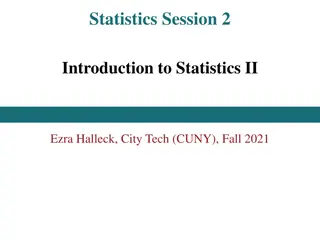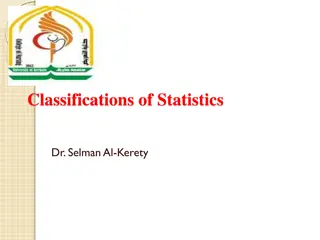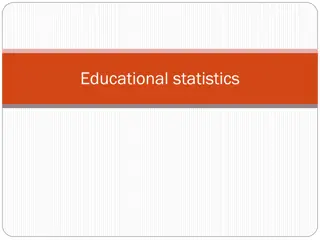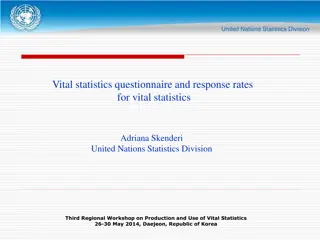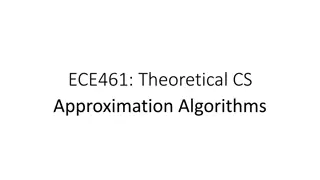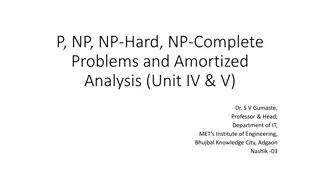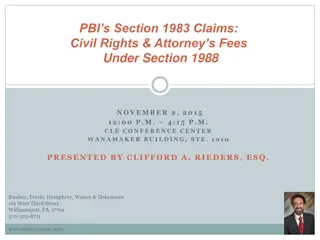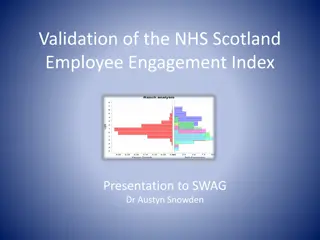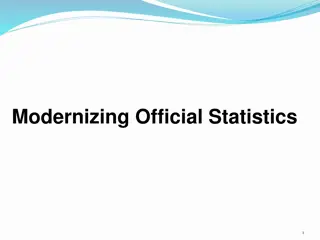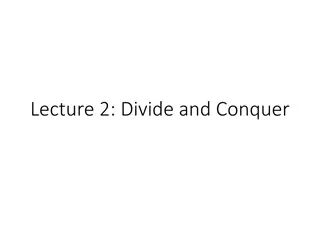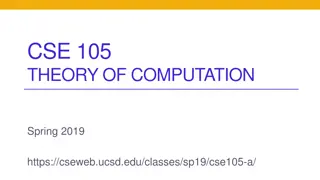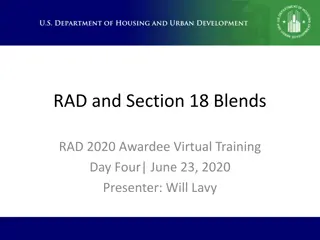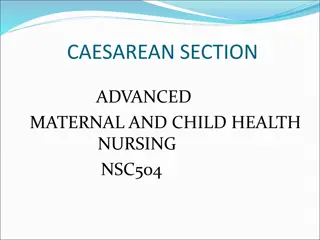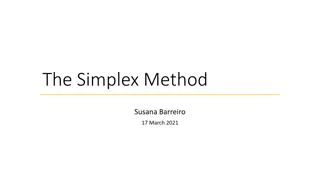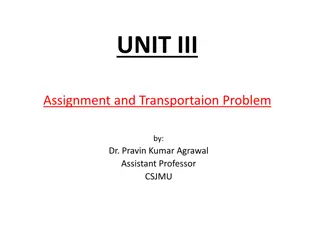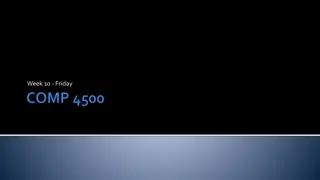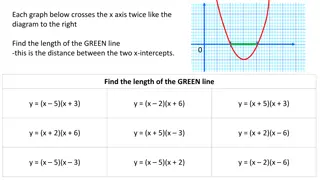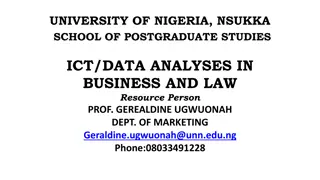Inferential Statistics Solutions for Challenging Problems in Section B
The provided statistical problems in Section B involve calculating the expected number of shoppers spending specific durations at a furniture shop and reasons for not checking the weight of each packet when filling corn flakes. Solutions include determining the shoppers expected to spend more than 40 minutes and between 20 and 35 minutes at the shop, as well as discussing practicality issues with checking packet weights individually.
Download Presentation

Please find below an Image/Link to download the presentation.
The content on the website is provided AS IS for your information and personal use only. It may not be sold, licensed, or shared on other websites without obtaining consent from the author. Download presentation by click this link. If you encounter any issues during the download, it is possible that the publisher has removed the file from their server.
E N D
Presentation Transcript
CHAPTER 25 Statistics IV Inferential Statistics Solutions: Revision Section B More challenging problems
25 Revision and Exam Style Questions: Section B 1. The time spent by shoppers at a furniture shop on a Saturday is approximately normally distributed with a mean of 30 minutes and a standard deviation of 5 minutes. If 2,850 shoppers are expected to visit the shop on a Saturday, how many shoppers are expected to spend: more than 40 minutes in the shop? (i) = 30 min = 5 min 40 minutes: 40 30 = 10 = 2(5) 40 minutes: + 2 2 35% + 0 15% > 40 mins 2 5% > 40 mins
25 Revision and Exam Style Questions: Section B 1. The time spent by shoppers at a furniture shop on a Saturday is approximately normally distributed with a mean of 30 minutes and a standard deviation of 5 minutes. If 2,850 shoppers are expected to visit the shop on a Saturday, how many shoppers are expected to spend: more than 40 minutes in the shop? (i) 2 5% of 2850 = 71 25 Since it is not possible to have of a person, the number of shoppers expected to spend more than 40 minutes in the shop is 71 shoppers.
25 Revision and Exam Style Questions: Section B 1. The time spent by shoppers at a furniture shop on a Saturday is approximately normally distributed with a mean of 30 minutes and a standard deviation of 5 minutes. If 2,850 shoppers are expected to visit the shop on a Saturday, how many shoppers are expected to spend: between 20 and 35 minutes in the shop? (ii) 35: + 20: 30 20 Between 20 and 35 minutes is: = 10 2 + = 2(5) 68% + 13 5% = 81 5% 20: 2 20 min < 81 5% < 35 min 35: 35 30 81 5% of 2850 = 2322 75 = 5 =
25 Revision and Exam Style Questions: Section B 1. The time spent by shoppers at a furniture shop on a Saturday is approximately normally distributed with a mean of 30 minutes and a standard deviation of 5 minutes. If 2,850 shoppers are expected to visit the shop on a Saturday, how many shoppers are expected to spend: between 20 and 35 minutes in the shop? (ii) Since it is not possible to have of a person, the number of shoppers are expected to spend between 20 and 35 minutes in the shop is 2322 shoppers.
25 Revision and Exam Style Questions: Section B 2. A machine fills packets with corn flakes. The label on each packet says the contents weigh 1 5 kg. At regular intervals a sample of 10 packets is taken from the machine. The sample mean is calculated. The sample means are normally distributed with a mean of 1,520 g and a standard deviation of 4 g. Give one reason why it may not be practical to check the weight of each packet. (i) It would be time-consuming and very expensive.
25 Revision and Exam Style Questions: Section B 2. A machine fills packets with corn flakes. The label on each packet says the contents weigh 1 5 kg. At regular intervals a sample of 10 packets is taken from the machine. The sample mean is calculated. The sample means are normally distributed with a mean of 1,520 g and a standard deviation of 4 g. Between what limits would you expect 95% of the sample means to lie? (ii) 95% : 2 + 2 (normally distributed) = 1,520 g = 4 g 1520 2(4) 1520 + 2(4) 1520 8 1520 + 8 1512 g 1528 g
25 Revision and Exam Style Questions: Section B 2. A machine fills packets with corn flakes. The label on each packet says the contents weigh 1 5 kg. At regular intervals a sample of 10 packets is taken from the machine. The sample mean is calculated. The sample means are normally distributed with a mean of 1,520 g and a standard deviation of 4 g. Martha takes a sample of 10 packets. She finds the weight, in grams, of each packet. (iii) Here are her results: 1,517 1,525 1,534 1,527 1,531 1,521 1,532 1,535 1,526 1,532
25 Revision and Exam Style Questions: Section B 2. A machine fills packets with corn flakes. The label on each packet says the contents weigh 1 5 kg. At regular intervals a sample of 10 packets is taken from the machine. The sample mean is calculated. The sample means are normally distributed with a mean of 1,520 g and a standard deviation of 4 g. The allowable limits for the weights are 1,520 g 3 standard deviations. How many of the sample would be rejected on these grounds? (iii) 1520 3 1520 + 3 1520 3(4) 1520 + 3(4) 1520 12 1520 + 12 1508 g 1532 g Two of the samples (1534 g, 1535 g) are outside the limits set and would be excluded.
25 Revision and Exam Style Questions: Section B 2. A machine fills packets with corn flakes. The label on each packet says the contents weigh 1 5 kg. At regular intervals a sample of 10 packets is taken from the machine. The sample mean is calculated. The sample means are normally distributed with a mean of 1,520 g and a standard deviation of 4 g. What could be done to ensure weights are within the acceptable range? (iv) The machine could be set to a lower weight.
25 Revision and Exam Style Questions: Section B 3. A drug company claims that the success rate of a treatment for a disease is 47%. Dr Green doubts this claim and wants to test it. He uses the treatment on 50 patients with the disease and cures 24 of them. Is the company s claim correct? Justify your answer. H0: The success rate for the treatment is 47%. H1: The success rate for the treatment is not 47%. p =24 50 =0 48
25 Revision and Exam Style Questions: Section B 3. A drug company claims that the success rate of a treatment for a disease is 47%. Dr. Green doubts this claim and wants to test it. He uses the treatment on 50 patients with the disease and cures 24 of them. Is the company s claim correct? Justify your answer. Margin of error =1 n 1 50 = =0 14 p-1 < p< p+1 95% confidence interval: n n 0 48 0 14 < p < 0 48 + 0 14 0 34 < p < 0 62 We fail to reject H0as 0 47 falls within the confidence interval. The company s claim appears to be true.
25 Revision and Exam Style Questions: Section B 4. A survey is being conducted of voters opinions on several different issues. What is the overall margin of error of the survey, at 95% confidence, if it is based on a simple random sample of 1,000 voters? (i) Margin of error =1 n 1 = 1000 =0 0316
25 Revision and Exam Style Questions: Section B A political party had claimed that it has the support of 26% of the electorate. Of the voters in the sample above, 238 stated that they support the party. 4. Is there sufficient evidence to reject the party s claim? Justify your answer. (ii) H0: Support for the party is 26%. H1: Support for the party is not 26%. p-1 < p< p+1 p=238 1000 Confidence interval: n n =0 238 0 24 0 03 < p < 0 24 + 0 03 0 21 < p < 0 27 Therefore, we fail to reject the H0 as 26% falls within the confidence interval. So, the party s claim appears to be true.
25 Revision and Exam Style Questions: Section B 5. A manufacturing company claims that 75% of suppliers recommend their brand of product. In a survey of 42 traders, 28 said that they would recommend the company s product. Use a hypothesis test at the 95% level of confidence to decide whether there is sufficient evidence to reject the company s claim. State clearly the null hypothesis and your conclusion. H0: The percentage of suppliers that would recommend the brand is 75%. H1: The percentage of suppliers that would recommend the brand is not 75%. p =28 42 =0 67
25 Revision and Exam Style Questions: Section B 5. A manufacturing company claims that 75% of suppliers recommend their brand of product. In a survey of 42 traders, 28 said that they would recommend the company s product. Use a hypothesis test at the 95% level of confidence to decide whether there is sufficient evidence to reject the company s claim. State clearly the null hypothesis and your conclusion. Margin of error =1 p-1 < p< p+1 Confidence interval: n 1 42 n n = 0 67 0 15 < p < 0 67 + 0 15 0 52 < p < 0 82 =0 1543 We fail to reject the null hypothesis as 0 75 falls within the confidence interval. Therefore, we can see that the company s claim appears to be true.
25 Revision and Exam Style Questions: Section B 6. A boy decides to test whether a coin is fair by tossing it 20 times and recording the number of heads. He suspects that it is more likely to show a head than a tail and when he tosses it he gets 11 heads. State suitable hypotheses to use for this test. (i) H0: The coin is fair and the chance of a tail is 0 5. H1: The coin is unfair and the chance of a head is not 0 5.
25 Revision and Exam Style Questions: Section B 6. A boy decides to test whether a coin is fair by tossing it 20 times and recording the number of heads. He suspects that it is more likely to show a head than a tail and when he tosses it he gets 11 heads. Use a 5% level of significance to test whether the coin is fair. (ii) p-1 < p< p+1 p =11 Confidence interval: 20 n n =0 55 0 55 0 22 < p < 0 55 + 0 22 Margin of error =1 0 33 < p < 0 77 n 1 20 = We fail to reject the null hypothesis as 0 5 falls within the confidence interval. =0 2236 Therefore, the coin is fair.
25 Revision and Exam Style Questions: Section B 6. A boy decides to test whether a coin is fair by tossing it 20 times and recording the number of heads. He suspects that it is more likely to show a head than a tail and when he tosses it he gets 11 heads. Do you think his results are reliable? Give a reason for the answer. (iii) No, the results are not reliable. The number of tosses is very small. 20 is too small a sample size. Having such a small sample size increases the margin of error greatly.
25 Revision and Exam Style Questions: Section B 7. In general, 55% of driving tests result in a pass. It is suspected that a particular examiner is tougher than usual. To investigate this, records are kept on the next 10 people tested by this examiner. Four of them pass. Stating your hypotheses carefully and showing your working in full, test at the 5% level of significance whether or not the examiner is tougher than normal. (i) H0: The examiners pass rate is 55%. H1: The examiners pass rate is not 55%. p =4 10 =0 4
25 Revision and Exam Style Questions: Section B 7. In general, 55% of driving tests result in a pass. It is suspected that a particular examiner is tougher than usual. To investigate this, records are kept on the next 10 people tested by this examiner. Four of them pass. Stating your hypotheses carefully and showing your working in full, test at the 5% level whether or not the examiner is tougher than normal. (i) Margin of error =1 p-1 < p< p+1 Confidence interval: n 1 10 n n = 0 4 0 32 < p < 0 4 + 0 32 0 08 < p < 0 72 =0 3162 We fail to reject the null hypothesis as 0 55 falls within the confidence interval. Therefore, we say the examiner is not tougher than normal.
25 Revision and Exam Style Questions: Section B 7. In general, 55% of driving tests result in a pass. It is suspected that a particular examiner is tougher than usual. To investigate this, records are kept on the next 10 people tested by this examiner. Four of them pass. Comment on the validity of this method of assessing the examiner. (ii) This is a very small sample to assess the examiner by and so the results presented are not necessarily valid. The small sample size leads to a high margin of error.
25 Revision and Exam Style Questions: Section B 8. On a production line in a factory, pineapple rings in syrup are put in tins. The label on each tin says that the contents weigh 415 g. Give two reasons why it is not practical to check the weight of the contents of each tin. (i) It would be very time consuming and very expensive.
25 Revision and Exam Style Questions: Section B 8. Samples of tins are taken at intervals and the weights of the contents are found. It has been found that the mean weight of the samples is 417 g and the standard deviation is 0 6 g. The mean weights of the samples are normally distributed. Between what limits would you expect 99 7% of the sample means to lie? (ii) = 417 g = 0 6 g 99 7% = 3 + 3 3 + 3 417 3(0 6) 417 + 3(0 6) 417 1 8 417 + 1 8 415 2 g 418 8 g
25 Revision and Exam Style Questions: Section B 8. Samples of tins are taken at intervals and the weights of the contents are found. It has been found that the mean weight of the samples is 417 g and the standard deviation is 0 6 g. The mean weights of the samples are normally distributed. A consumer authority inspects the factory and decides that the labels on the tins should be altered from 415 g. Use your answer from (ii) to explain why this is the case. (iii) Only a very small number will fall below 415 2 g (0 15%) and therefore, the majority of tins weigh 415 g.




